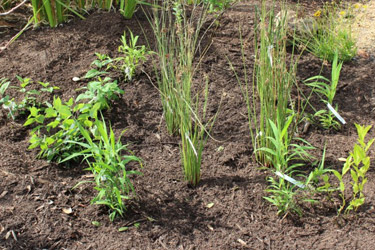RainWise Landscapes
Restore the natural ability of our landscapes to manage stormwater runoff by using the absorbing and filtering abilities of plants, trees and soils.
In a healthy natural landscape, trees and other vegetation play an important role in managing rainwater, including:
- trees capture rainfall on their leaves, slowing the raindrop impact and allowing some water to evaporate;
- roots loosen the soil, improving infiltration and increasing water absorbed;
- roots soak up excess water from the soil making the soil drier and able to store more rainwater;
- roots hold the soil in place, reducing the movement of sediment that can shrink stream and river channels downstream; and,
- roots absorb ground water and transpire it back into the atmosphere.
Rainwater naturally spreads out over the soil and plants, then filters and soaks into the soil where tree roots and understory plants anchor the soil minimizing further erosion. The rainwater eventually feeds into groundwater, streams, wetlands, rivers, and coastal waters. However, due to urbanization, these natural landscapes are increasingly converted to commercial, residential or industrial uses. This conversion destroys the natural infiltration process when natural landscapes are replaced with impervious surfaces. Impervious surfaces are hard surfaces that do not allow water to penetrate the soil such as rooftops, asphalt and concrete roads, driveways, sidewalks, parking lots, patios and compacted turf lawns and soils.
In the built environment, stormwater flows across hard impervious surfaces and runs directly into sewer drains, ditches or waterways, all without the benefit of the absorbing and filtering abilities of our natural landscapes. The speed and volume of stormwater can cause flooding, clogged stream channels and streambank erosion. In many older cities, stormwater can overwhelm sanitary sewers, sending raw sewage as well as runoff into nearby waterways.
As the stormwater flows over these surfaces, it collects sediment, fertilizers, pesticides, oils, pet waste, trash and other pollutants. These pollutants eventually run into storm drains, which empty into the nearest stream or waterbody, causing nonpoint source pollution. These pollutants are carried into rivers, streams, lakes, marshes and oceans making them unfit for human recreation, fouling drinking water supplies and damaging natural ecosystems.
Learn how impervious cover affects infiltration and runoff.
With natural groundcover, 50 percent of rain infiltrates into the aquifer and only 10 percent ends up as runoff. As imperviousness increases, less water infiltrates and recharges groundwater, and more runs off. In highly urbanized areas, over one-half of all rain becomes surface runoff, and deep infiltration is only a fraction of what it was naturally. The increased surface runoff requires more infrastructure to minimize flooding.
Be RainWise!
We can restore the natural ability of our landscapes to manage runoff from the rooftop to the stream by using the absorbing and filtering abilities of plants, trees and soils. We can collect and distribute runoff from roofs, driveways and landscape to help slow it, spread it, filter it and soak it in.
By using these green solutions, we protect water quality, reduce runoff rates and volumes, reduce property and wildlife habitat damage due to erosion and flash flooding, recharge groundwater supplies and reduce the amount of pollutants from human activities. We can help our communities work more like a forest or meadow by taking some simple steps around our homes, businesses, schools, parks and communities – by being RainWise.
Replace impervious hard surfaces with porous surfaces.
Reduce paved impervious hard surfaces. Consider removing unnecessary paved areas around your landscape. Driveways and sidewalks can be narrower, or consider two paved tracks with grass in between. Consider incorporating small native planting beds and groundcovers into the edges of walkways and patios, which help slow stormwater flow.
Replace impervious hard surfaces with porous materials. Porous surfaces allow rain to soak directly into the soils.
Maintain RainWise systems to keep them working.
Whether it is a simple mulch layer, a cistern or rain garden, your annual maintenance practices can help reduce storm runoff and keep it clean. Renew mulch layers, weed rain gardens, sweep off porous paving, check valves and make sure inlets and gutters aren’t clogged. Remember to go out in a big rainstorm to make sure that everything is flowing where it should. Work with neighbors and your community to keep leaves and debris out of storm drains.

